Strategic Management Assessment Report: Tesco Analysis (SIM336)
VerifiedAdded on 2023/01/18
|13
|3369
|55
Report
AI Summary
This report provides a comprehensive analysis of Tesco's strategic management, addressing its origins, various approaches, and the complexities of its environment. It explores international and global strategic thinking, as well as the practical application of strategic ideas. The report delves into Tesco's environment using PESTEL and SWOT analyses, examining its strengths, weaknesses, opportunities, and threats. It synthesizes diverse studies and theoretical models to offer solutions to strategic issues, evaluating existing methodologies against real-world practices. The report covers key concepts such as unilateral, AdHoc, administrative, and collaborative firms, and their impact on decision-making. It also examines the interplay between organizations and their environment, including resource exchange, influence, and power dynamics. Furthermore, it provides an overview of international, multinational, and global strategies, discussing their implications and applications. Finally, the report highlights the importance of strategy as practice, emphasizing the role of strategists in creating organizational value.
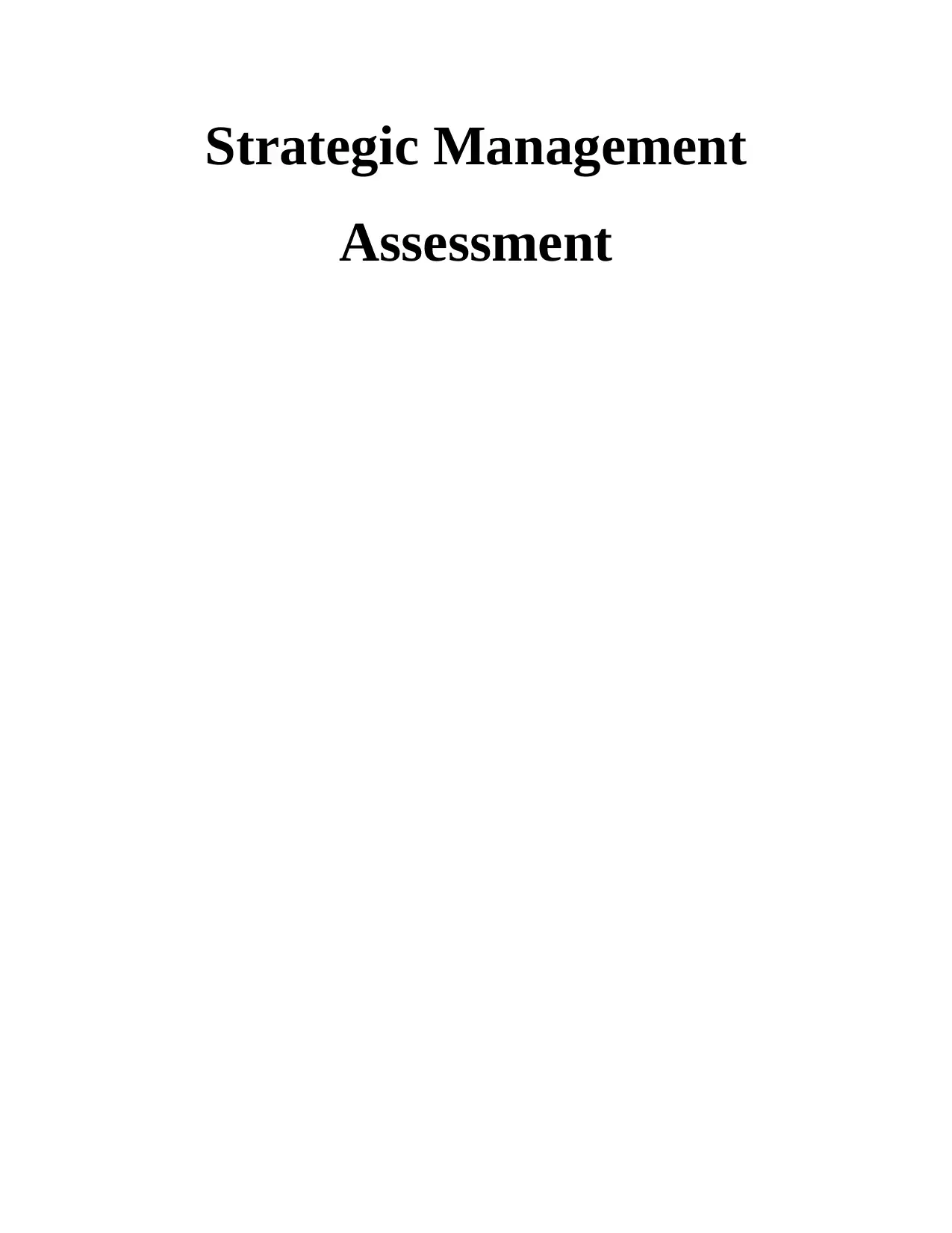
Strategic Management
Assessment
Assessment
Paraphrase This Document
Need a fresh take? Get an instant paraphrase of this document with our AI Paraphraser

Table of content
Introduction 2
Conclusion 12
References 13
Introduction 2
Conclusion 12
References 13
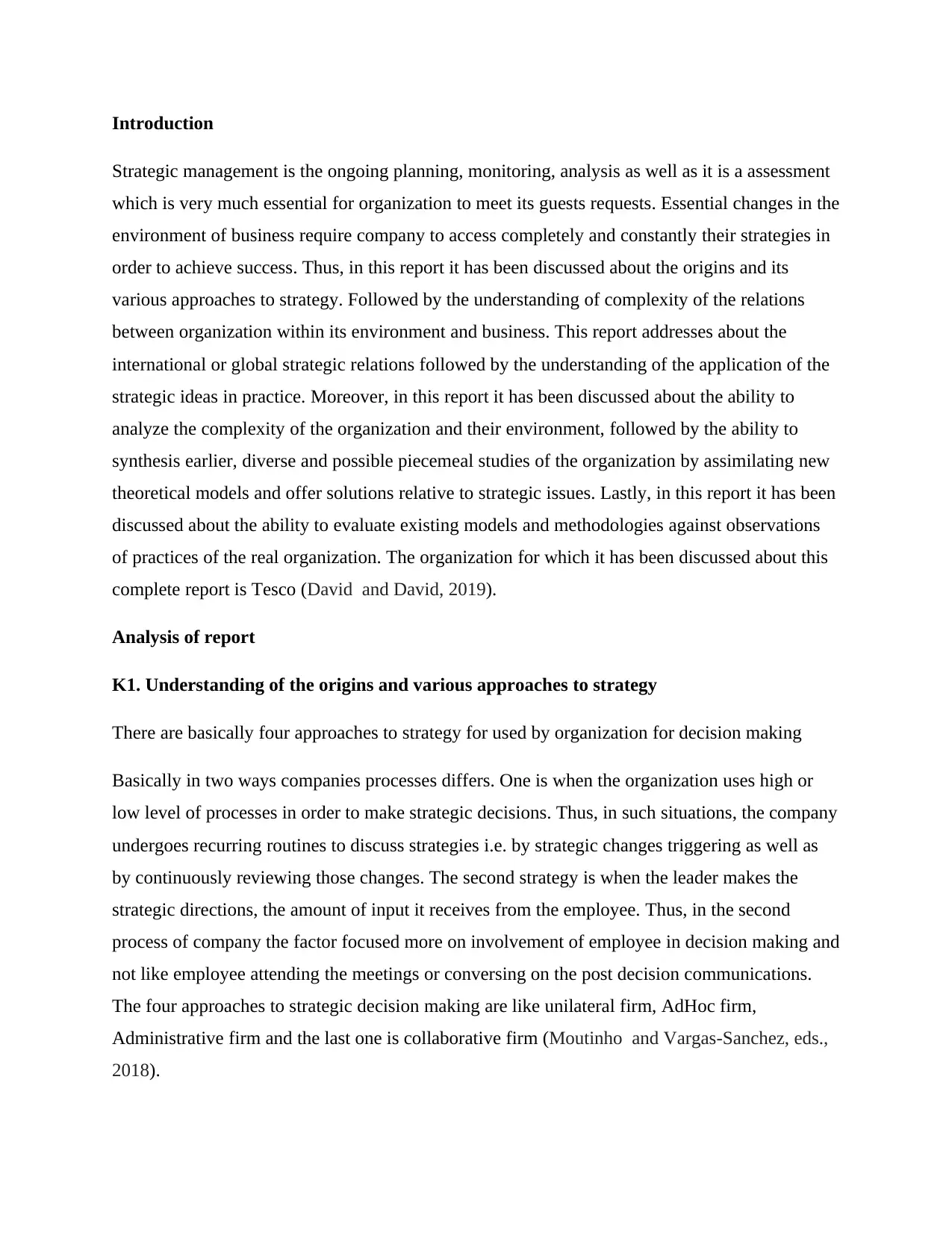
Introduction
Strategic management is the ongoing planning, monitoring, analysis as well as it is a assessment
which is very much essential for organization to meet its guests requests. Essential changes in the
environment of business require company to access completely and constantly their strategies in
order to achieve success. Thus, in this report it has been discussed about the origins and its
various approaches to strategy. Followed by the understanding of complexity of the relations
between organization within its environment and business. This report addresses about the
international or global strategic relations followed by the understanding of the application of the
strategic ideas in practice. Moreover, in this report it has been discussed about the ability to
analyze the complexity of the organization and their environment, followed by the ability to
synthesis earlier, diverse and possible piecemeal studies of the organization by assimilating new
theoretical models and offer solutions relative to strategic issues. Lastly, in this report it has been
discussed about the ability to evaluate existing models and methodologies against observations
of practices of the real organization. The organization for which it has been discussed about this
complete report is Tesco (David and David, 2019).
Analysis of report
K1. Understanding of the origins and various approaches to strategy
There are basically four approaches to strategy for used by organization for decision making
Basically in two ways companies processes differs. One is when the organization uses high or
low level of processes in order to make strategic decisions. Thus, in such situations, the company
undergoes recurring routines to discuss strategies i.e. by strategic changes triggering as well as
by continuously reviewing those changes. The second strategy is when the leader makes the
strategic directions, the amount of input it receives from the employee. Thus, in the second
process of company the factor focused more on involvement of employee in decision making and
not like employee attending the meetings or conversing on the post decision communications.
The four approaches to strategic decision making are like unilateral firm, AdHoc firm,
Administrative firm and the last one is collaborative firm (Moutinho and Vargas-Sanchez, eds.,
2018).
Strategic management is the ongoing planning, monitoring, analysis as well as it is a assessment
which is very much essential for organization to meet its guests requests. Essential changes in the
environment of business require company to access completely and constantly their strategies in
order to achieve success. Thus, in this report it has been discussed about the origins and its
various approaches to strategy. Followed by the understanding of complexity of the relations
between organization within its environment and business. This report addresses about the
international or global strategic relations followed by the understanding of the application of the
strategic ideas in practice. Moreover, in this report it has been discussed about the ability to
analyze the complexity of the organization and their environment, followed by the ability to
synthesis earlier, diverse and possible piecemeal studies of the organization by assimilating new
theoretical models and offer solutions relative to strategic issues. Lastly, in this report it has been
discussed about the ability to evaluate existing models and methodologies against observations
of practices of the real organization. The organization for which it has been discussed about this
complete report is Tesco (David and David, 2019).
Analysis of report
K1. Understanding of the origins and various approaches to strategy
There are basically four approaches to strategy for used by organization for decision making
Basically in two ways companies processes differs. One is when the organization uses high or
low level of processes in order to make strategic decisions. Thus, in such situations, the company
undergoes recurring routines to discuss strategies i.e. by strategic changes triggering as well as
by continuously reviewing those changes. The second strategy is when the leader makes the
strategic directions, the amount of input it receives from the employee. Thus, in the second
process of company the factor focused more on involvement of employee in decision making and
not like employee attending the meetings or conversing on the post decision communications.
The four approaches to strategic decision making are like unilateral firm, AdHoc firm,
Administrative firm and the last one is collaborative firm (Moutinho and Vargas-Sanchez, eds.,
2018).
⊘ This is a preview!⊘
Do you want full access?
Subscribe today to unlock all pages.

Trusted by 1+ million students worldwide
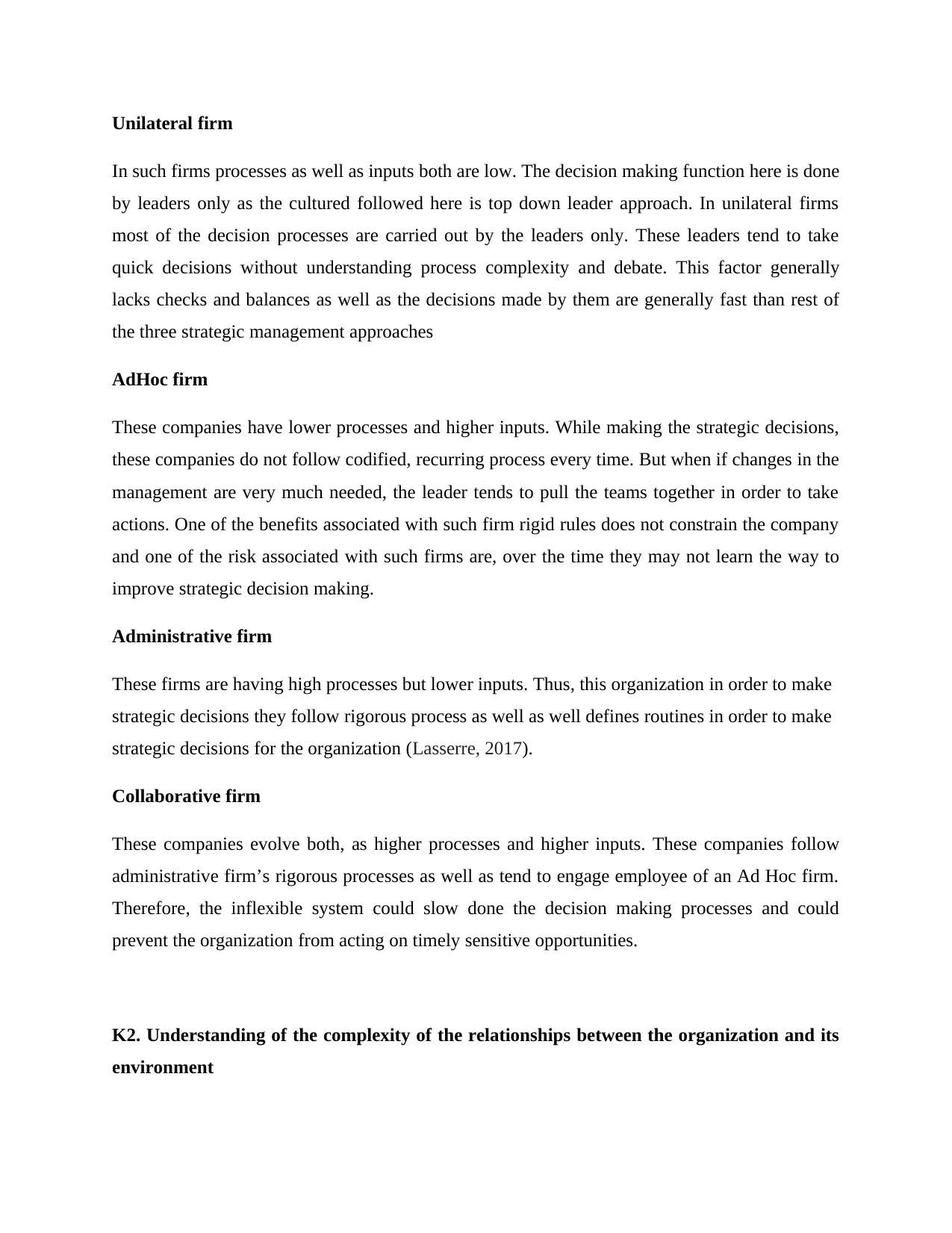
Unilateral firm
In such firms processes as well as inputs both are low. The decision making function here is done
by leaders only as the cultured followed here is top down leader approach. In unilateral firms
most of the decision processes are carried out by the leaders only. These leaders tend to take
quick decisions without understanding process complexity and debate. This factor generally
lacks checks and balances as well as the decisions made by them are generally fast than rest of
the three strategic management approaches
AdHoc firm
These companies have lower processes and higher inputs. While making the strategic decisions,
these companies do not follow codified, recurring process every time. But when if changes in the
management are very much needed, the leader tends to pull the teams together in order to take
actions. One of the benefits associated with such firm rigid rules does not constrain the company
and one of the risk associated with such firms are, over the time they may not learn the way to
improve strategic decision making.
Administrative firm
These firms are having high processes but lower inputs. Thus, this organization in order to make
strategic decisions they follow rigorous process as well as well defines routines in order to make
strategic decisions for the organization (Lasserre, 2017).
Collaborative firm
These companies evolve both, as higher processes and higher inputs. These companies follow
administrative firm’s rigorous processes as well as tend to engage employee of an Ad Hoc firm.
Therefore, the inflexible system could slow done the decision making processes and could
prevent the organization from acting on timely sensitive opportunities.
K2. Understanding of the complexity of the relationships between the organization and its
environment
In such firms processes as well as inputs both are low. The decision making function here is done
by leaders only as the cultured followed here is top down leader approach. In unilateral firms
most of the decision processes are carried out by the leaders only. These leaders tend to take
quick decisions without understanding process complexity and debate. This factor generally
lacks checks and balances as well as the decisions made by them are generally fast than rest of
the three strategic management approaches
AdHoc firm
These companies have lower processes and higher inputs. While making the strategic decisions,
these companies do not follow codified, recurring process every time. But when if changes in the
management are very much needed, the leader tends to pull the teams together in order to take
actions. One of the benefits associated with such firm rigid rules does not constrain the company
and one of the risk associated with such firms are, over the time they may not learn the way to
improve strategic decision making.
Administrative firm
These firms are having high processes but lower inputs. Thus, this organization in order to make
strategic decisions they follow rigorous process as well as well defines routines in order to make
strategic decisions for the organization (Lasserre, 2017).
Collaborative firm
These companies evolve both, as higher processes and higher inputs. These companies follow
administrative firm’s rigorous processes as well as tend to engage employee of an Ad Hoc firm.
Therefore, the inflexible system could slow done the decision making processes and could
prevent the organization from acting on timely sensitive opportunities.
K2. Understanding of the complexity of the relationships between the organization and its
environment
Paraphrase This Document
Need a fresh take? Get an instant paraphrase of this document with our AI Paraphraser
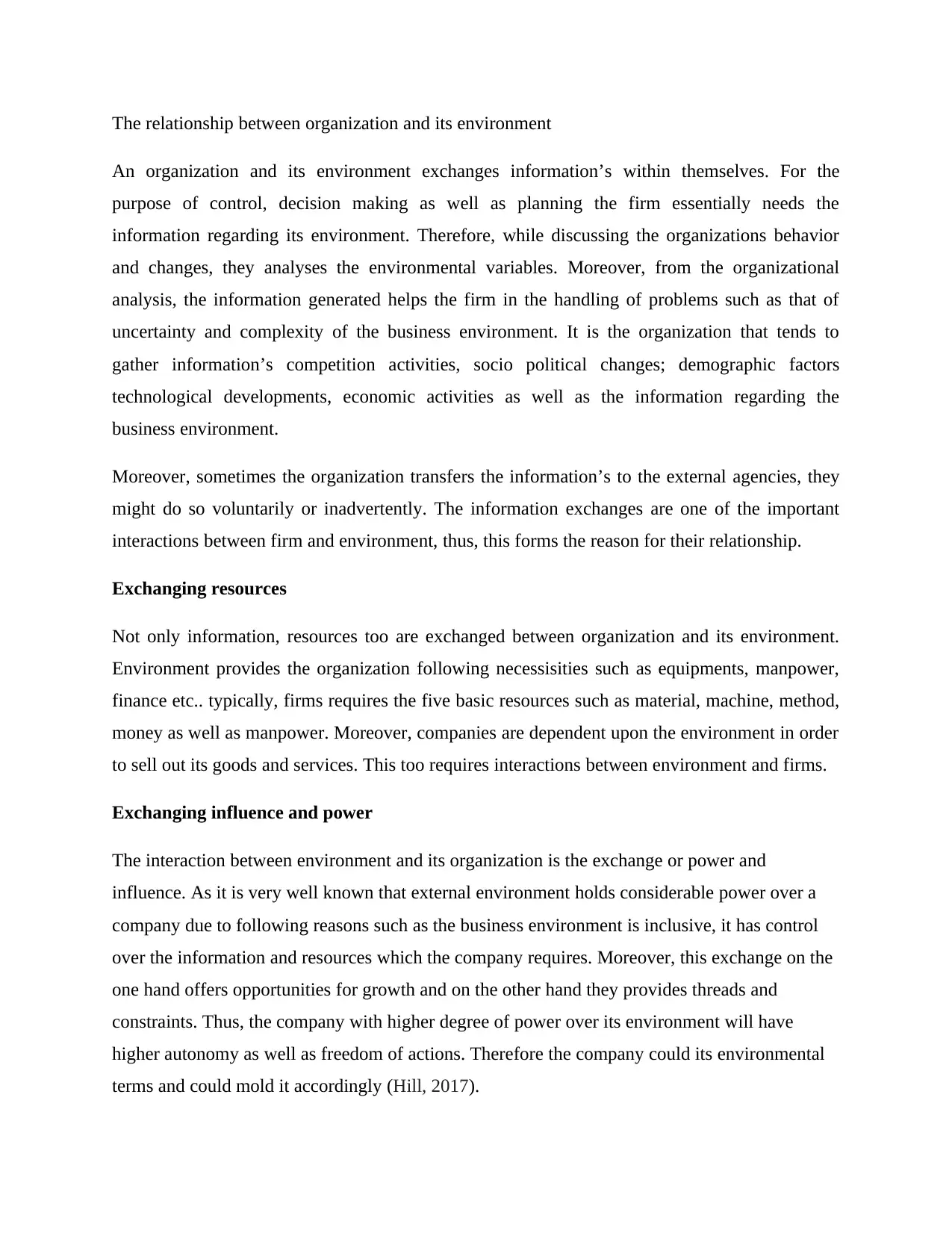
The relationship between organization and its environment
An organization and its environment exchanges information’s within themselves. For the
purpose of control, decision making as well as planning the firm essentially needs the
information regarding its environment. Therefore, while discussing the organizations behavior
and changes, they analyses the environmental variables. Moreover, from the organizational
analysis, the information generated helps the firm in the handling of problems such as that of
uncertainty and complexity of the business environment. It is the organization that tends to
gather information’s competition activities, socio political changes; demographic factors
technological developments, economic activities as well as the information regarding the
business environment.
Moreover, sometimes the organization transfers the information’s to the external agencies, they
might do so voluntarily or inadvertently. The information exchanges are one of the important
interactions between firm and environment, thus, this forms the reason for their relationship.
Exchanging resources
Not only information, resources too are exchanged between organization and its environment.
Environment provides the organization following necessisities such as equipments, manpower,
finance etc.. typically, firms requires the five basic resources such as material, machine, method,
money as well as manpower. Moreover, companies are dependent upon the environment in order
to sell out its goods and services. This too requires interactions between environment and firms.
Exchanging influence and power
The interaction between environment and its organization is the exchange or power and
influence. As it is very well known that external environment holds considerable power over a
company due to following reasons such as the business environment is inclusive, it has control
over the information and resources which the company requires. Moreover, this exchange on the
one hand offers opportunities for growth and on the other hand they provides threads and
constraints. Thus, the company with higher degree of power over its environment will have
higher autonomy as well as freedom of actions. Therefore the company could its environmental
terms and could mold it accordingly (Hill, 2017).
An organization and its environment exchanges information’s within themselves. For the
purpose of control, decision making as well as planning the firm essentially needs the
information regarding its environment. Therefore, while discussing the organizations behavior
and changes, they analyses the environmental variables. Moreover, from the organizational
analysis, the information generated helps the firm in the handling of problems such as that of
uncertainty and complexity of the business environment. It is the organization that tends to
gather information’s competition activities, socio political changes; demographic factors
technological developments, economic activities as well as the information regarding the
business environment.
Moreover, sometimes the organization transfers the information’s to the external agencies, they
might do so voluntarily or inadvertently. The information exchanges are one of the important
interactions between firm and environment, thus, this forms the reason for their relationship.
Exchanging resources
Not only information, resources too are exchanged between organization and its environment.
Environment provides the organization following necessisities such as equipments, manpower,
finance etc.. typically, firms requires the five basic resources such as material, machine, method,
money as well as manpower. Moreover, companies are dependent upon the environment in order
to sell out its goods and services. This too requires interactions between environment and firms.
Exchanging influence and power
The interaction between environment and its organization is the exchange or power and
influence. As it is very well known that external environment holds considerable power over a
company due to following reasons such as the business environment is inclusive, it has control
over the information and resources which the company requires. Moreover, this exchange on the
one hand offers opportunities for growth and on the other hand they provides threads and
constraints. Thus, the company with higher degree of power over its environment will have
higher autonomy as well as freedom of actions. Therefore the company could its environmental
terms and could mold it accordingly (Hill, 2017).
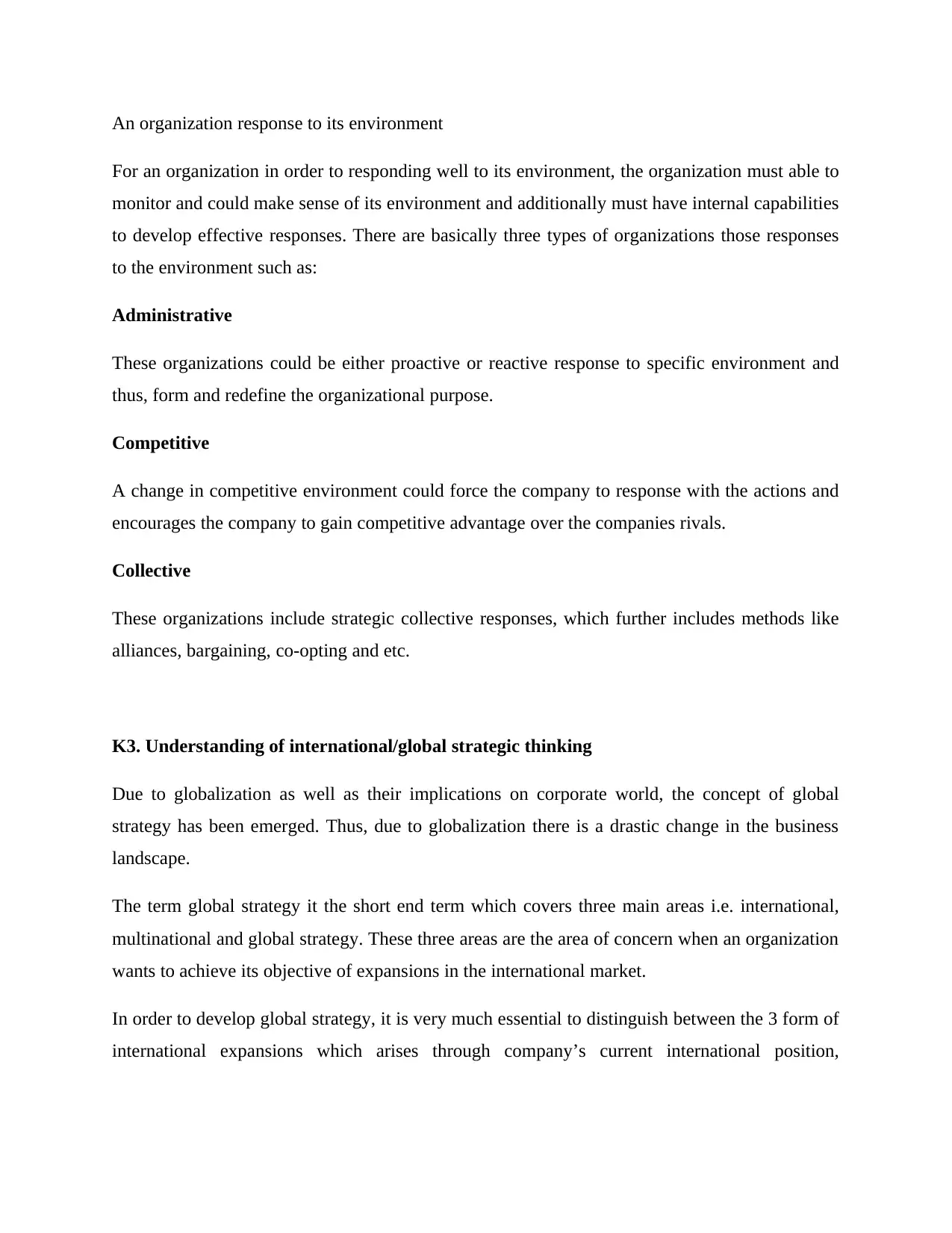
An organization response to its environment
For an organization in order to responding well to its environment, the organization must able to
monitor and could make sense of its environment and additionally must have internal capabilities
to develop effective responses. There are basically three types of organizations those responses
to the environment such as:
Administrative
These organizations could be either proactive or reactive response to specific environment and
thus, form and redefine the organizational purpose.
Competitive
A change in competitive environment could force the company to response with the actions and
encourages the company to gain competitive advantage over the companies rivals.
Collective
These organizations include strategic collective responses, which further includes methods like
alliances, bargaining, co-opting and etc.
K3. Understanding of international/global strategic thinking
Due to globalization as well as their implications on corporate world, the concept of global
strategy has been emerged. Thus, due to globalization there is a drastic change in the business
landscape.
The term global strategy it the short end term which covers three main areas i.e. international,
multinational and global strategy. These three areas are the area of concern when an organization
wants to achieve its objective of expansions in the international market.
In order to develop global strategy, it is very much essential to distinguish between the 3 form of
international expansions which arises through company’s current international position,
For an organization in order to responding well to its environment, the organization must able to
monitor and could make sense of its environment and additionally must have internal capabilities
to develop effective responses. There are basically three types of organizations those responses
to the environment such as:
Administrative
These organizations could be either proactive or reactive response to specific environment and
thus, form and redefine the organizational purpose.
Competitive
A change in competitive environment could force the company to response with the actions and
encourages the company to gain competitive advantage over the companies rivals.
Collective
These organizations include strategic collective responses, which further includes methods like
alliances, bargaining, co-opting and etc.
K3. Understanding of international/global strategic thinking
Due to globalization as well as their implications on corporate world, the concept of global
strategy has been emerged. Thus, due to globalization there is a drastic change in the business
landscape.
The term global strategy it the short end term which covers three main areas i.e. international,
multinational and global strategy. These three areas are the area of concern when an organization
wants to achieve its objective of expansions in the international market.
In order to develop global strategy, it is very much essential to distinguish between the 3 form of
international expansions which arises through company’s current international position,
⊘ This is a preview!⊘
Do you want full access?
Subscribe today to unlock all pages.

Trusted by 1+ million students worldwide
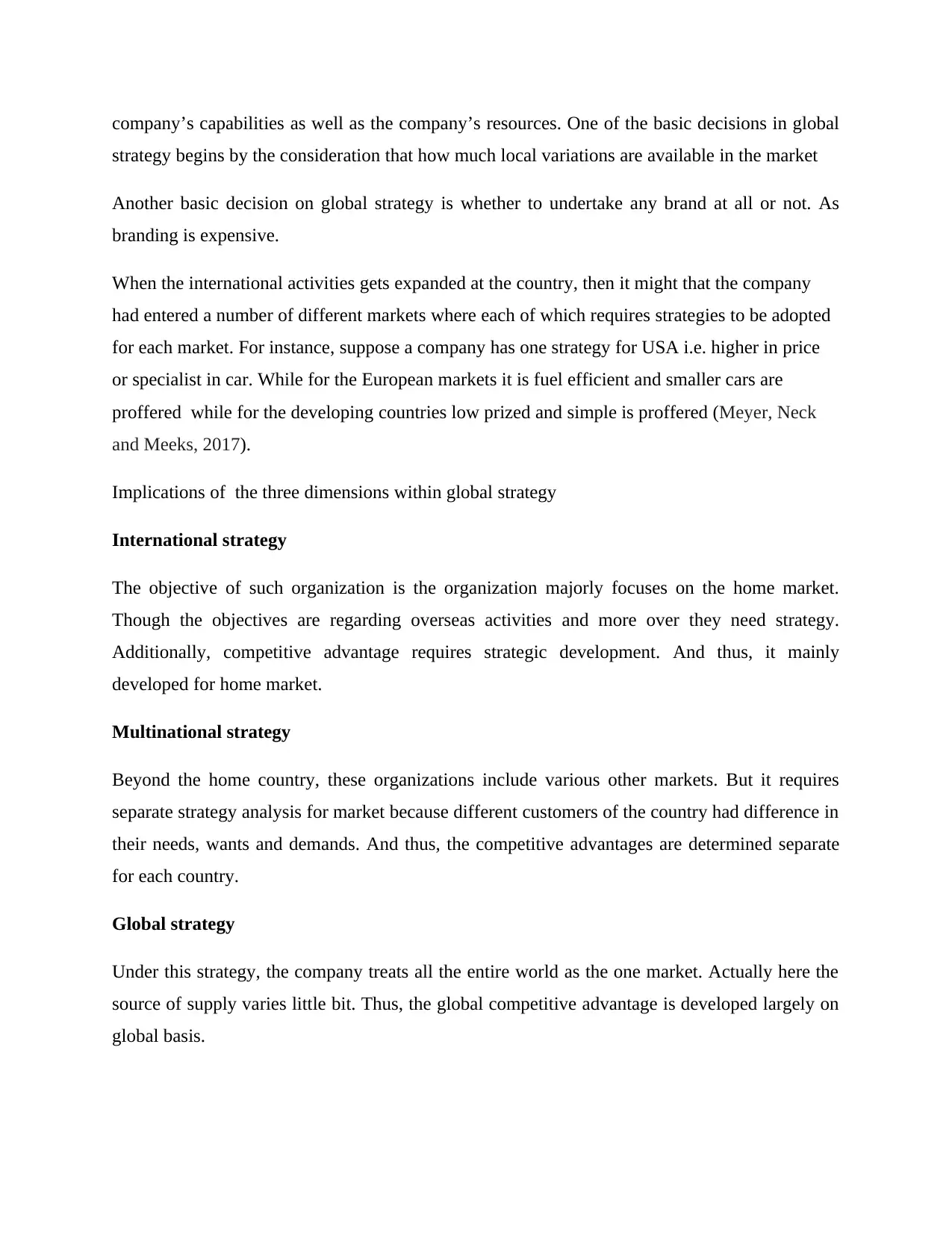
company’s capabilities as well as the company’s resources. One of the basic decisions in global
strategy begins by the consideration that how much local variations are available in the market
Another basic decision on global strategy is whether to undertake any brand at all or not. As
branding is expensive.
When the international activities gets expanded at the country, then it might that the company
had entered a number of different markets where each of which requires strategies to be adopted
for each market. For instance, suppose a company has one strategy for USA i.e. higher in price
or specialist in car. While for the European markets it is fuel efficient and smaller cars are
proffered while for the developing countries low prized and simple is proffered (Meyer, Neck
and Meeks, 2017).
Implications of the three dimensions within global strategy
International strategy
The objective of such organization is the organization majorly focuses on the home market.
Though the objectives are regarding overseas activities and more over they need strategy.
Additionally, competitive advantage requires strategic development. And thus, it mainly
developed for home market.
Multinational strategy
Beyond the home country, these organizations include various other markets. But it requires
separate strategy analysis for market because different customers of the country had difference in
their needs, wants and demands. And thus, the competitive advantages are determined separate
for each country.
Global strategy
Under this strategy, the company treats all the entire world as the one market. Actually here the
source of supply varies little bit. Thus, the global competitive advantage is developed largely on
global basis.
strategy begins by the consideration that how much local variations are available in the market
Another basic decision on global strategy is whether to undertake any brand at all or not. As
branding is expensive.
When the international activities gets expanded at the country, then it might that the company
had entered a number of different markets where each of which requires strategies to be adopted
for each market. For instance, suppose a company has one strategy for USA i.e. higher in price
or specialist in car. While for the European markets it is fuel efficient and smaller cars are
proffered while for the developing countries low prized and simple is proffered (Meyer, Neck
and Meeks, 2017).
Implications of the three dimensions within global strategy
International strategy
The objective of such organization is the organization majorly focuses on the home market.
Though the objectives are regarding overseas activities and more over they need strategy.
Additionally, competitive advantage requires strategic development. And thus, it mainly
developed for home market.
Multinational strategy
Beyond the home country, these organizations include various other markets. But it requires
separate strategy analysis for market because different customers of the country had difference in
their needs, wants and demands. And thus, the competitive advantages are determined separate
for each country.
Global strategy
Under this strategy, the company treats all the entire world as the one market. Actually here the
source of supply varies little bit. Thus, the global competitive advantage is developed largely on
global basis.
Paraphrase This Document
Need a fresh take? Get an instant paraphrase of this document with our AI Paraphraser
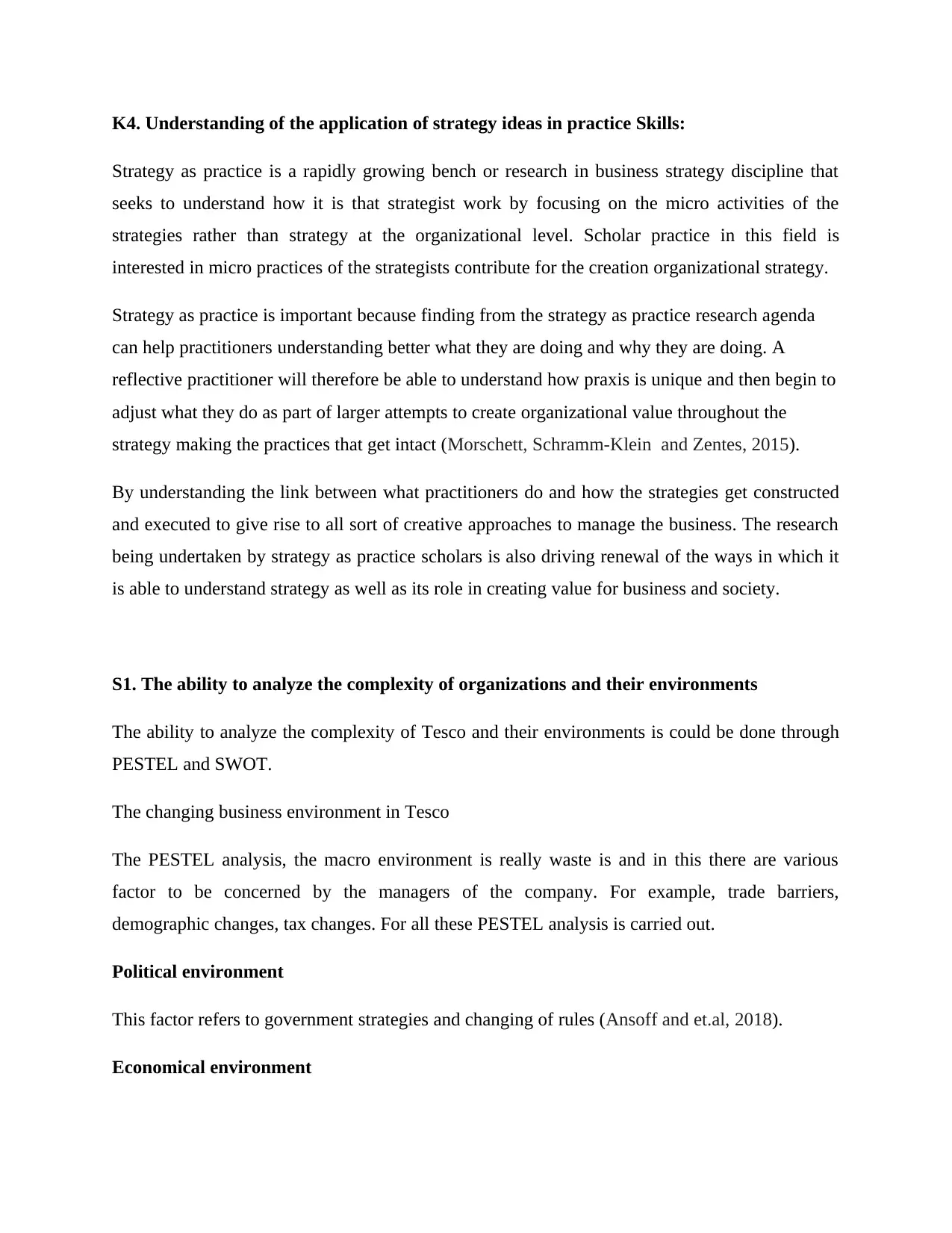
K4. Understanding of the application of strategy ideas in practice Skills:
Strategy as practice is a rapidly growing bench or research in business strategy discipline that
seeks to understand how it is that strategist work by focusing on the micro activities of the
strategies rather than strategy at the organizational level. Scholar practice in this field is
interested in micro practices of the strategists contribute for the creation organizational strategy.
Strategy as practice is important because finding from the strategy as practice research agenda
can help practitioners understanding better what they are doing and why they are doing. A
reflective practitioner will therefore be able to understand how praxis is unique and then begin to
adjust what they do as part of larger attempts to create organizational value throughout the
strategy making the practices that get intact (Morschett, Schramm-Klein and Zentes, 2015).
By understanding the link between what practitioners do and how the strategies get constructed
and executed to give rise to all sort of creative approaches to manage the business. The research
being undertaken by strategy as practice scholars is also driving renewal of the ways in which it
is able to understand strategy as well as its role in creating value for business and society.
S1. The ability to analyze the complexity of organizations and their environments
The ability to analyze the complexity of Tesco and their environments is could be done through
PESTEL and SWOT.
The changing business environment in Tesco
The PESTEL analysis, the macro environment is really waste is and in this there are various
factor to be concerned by the managers of the company. For example, trade barriers,
demographic changes, tax changes. For all these PESTEL analysis is carried out.
Political environment
This factor refers to government strategies and changing of rules (Ansoff and et.al, 2018).
Economical environment
Strategy as practice is a rapidly growing bench or research in business strategy discipline that
seeks to understand how it is that strategist work by focusing on the micro activities of the
strategies rather than strategy at the organizational level. Scholar practice in this field is
interested in micro practices of the strategists contribute for the creation organizational strategy.
Strategy as practice is important because finding from the strategy as practice research agenda
can help practitioners understanding better what they are doing and why they are doing. A
reflective practitioner will therefore be able to understand how praxis is unique and then begin to
adjust what they do as part of larger attempts to create organizational value throughout the
strategy making the practices that get intact (Morschett, Schramm-Klein and Zentes, 2015).
By understanding the link between what practitioners do and how the strategies get constructed
and executed to give rise to all sort of creative approaches to manage the business. The research
being undertaken by strategy as practice scholars is also driving renewal of the ways in which it
is able to understand strategy as well as its role in creating value for business and society.
S1. The ability to analyze the complexity of organizations and their environments
The ability to analyze the complexity of Tesco and their environments is could be done through
PESTEL and SWOT.
The changing business environment in Tesco
The PESTEL analysis, the macro environment is really waste is and in this there are various
factor to be concerned by the managers of the company. For example, trade barriers,
demographic changes, tax changes. For all these PESTEL analysis is carried out.
Political environment
This factor refers to government strategies and changing of rules (Ansoff and et.al, 2018).
Economical environment
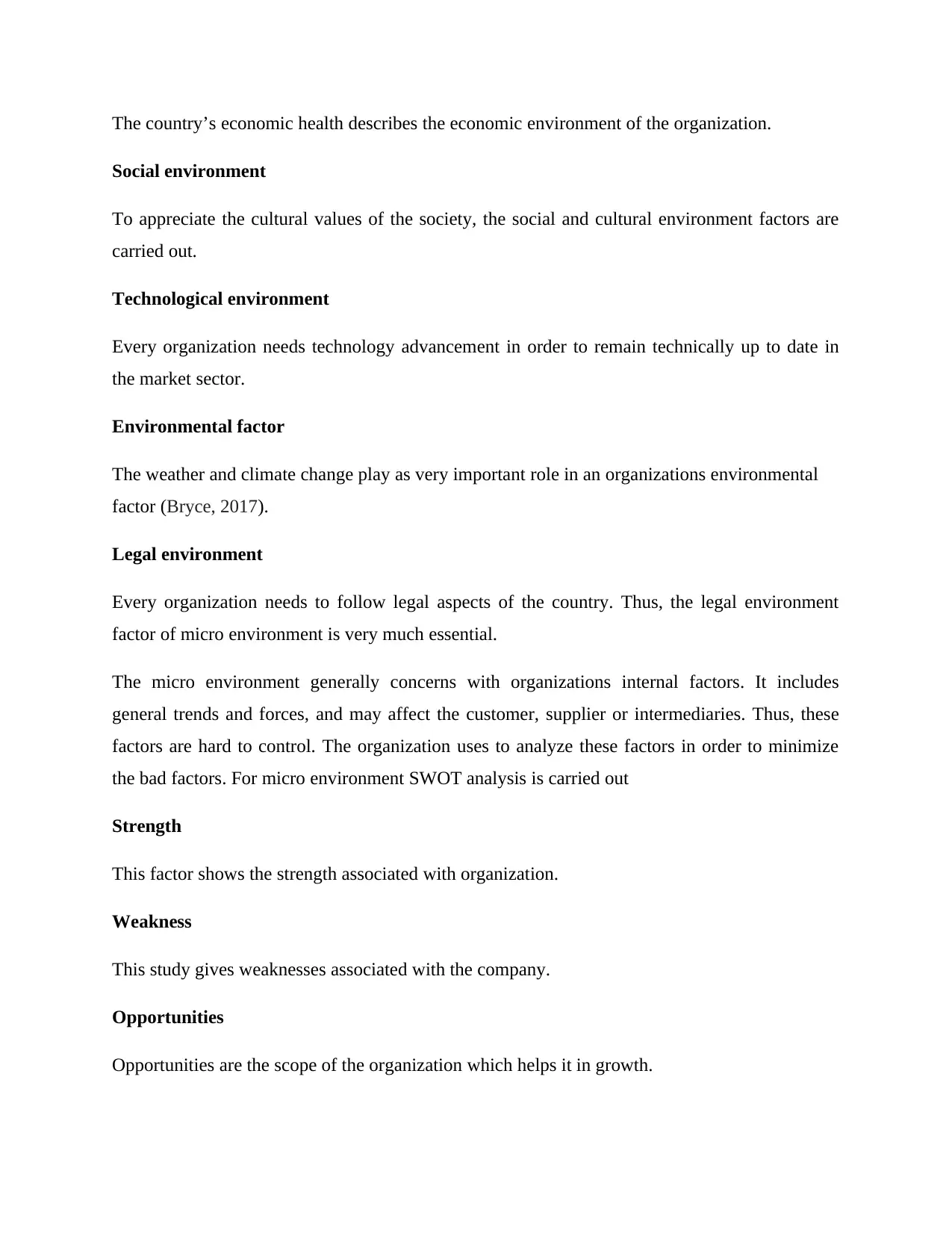
The country’s economic health describes the economic environment of the organization.
Social environment
To appreciate the cultural values of the society, the social and cultural environment factors are
carried out.
Technological environment
Every organization needs technology advancement in order to remain technically up to date in
the market sector.
Environmental factor
The weather and climate change play as very important role in an organizations environmental
factor (Bryce, 2017).
Legal environment
Every organization needs to follow legal aspects of the country. Thus, the legal environment
factor of micro environment is very much essential.
The micro environment generally concerns with organizations internal factors. It includes
general trends and forces, and may affect the customer, supplier or intermediaries. Thus, these
factors are hard to control. The organization uses to analyze these factors in order to minimize
the bad factors. For micro environment SWOT analysis is carried out
Strength
This factor shows the strength associated with organization.
Weakness
This study gives weaknesses associated with the company.
Opportunities
Opportunities are the scope of the organization which helps it in growth.
Social environment
To appreciate the cultural values of the society, the social and cultural environment factors are
carried out.
Technological environment
Every organization needs technology advancement in order to remain technically up to date in
the market sector.
Environmental factor
The weather and climate change play as very important role in an organizations environmental
factor (Bryce, 2017).
Legal environment
Every organization needs to follow legal aspects of the country. Thus, the legal environment
factor of micro environment is very much essential.
The micro environment generally concerns with organizations internal factors. It includes
general trends and forces, and may affect the customer, supplier or intermediaries. Thus, these
factors are hard to control. The organization uses to analyze these factors in order to minimize
the bad factors. For micro environment SWOT analysis is carried out
Strength
This factor shows the strength associated with organization.
Weakness
This study gives weaknesses associated with the company.
Opportunities
Opportunities are the scope of the organization which helps it in growth.
⊘ This is a preview!⊘
Do you want full access?
Subscribe today to unlock all pages.

Trusted by 1+ million students worldwide
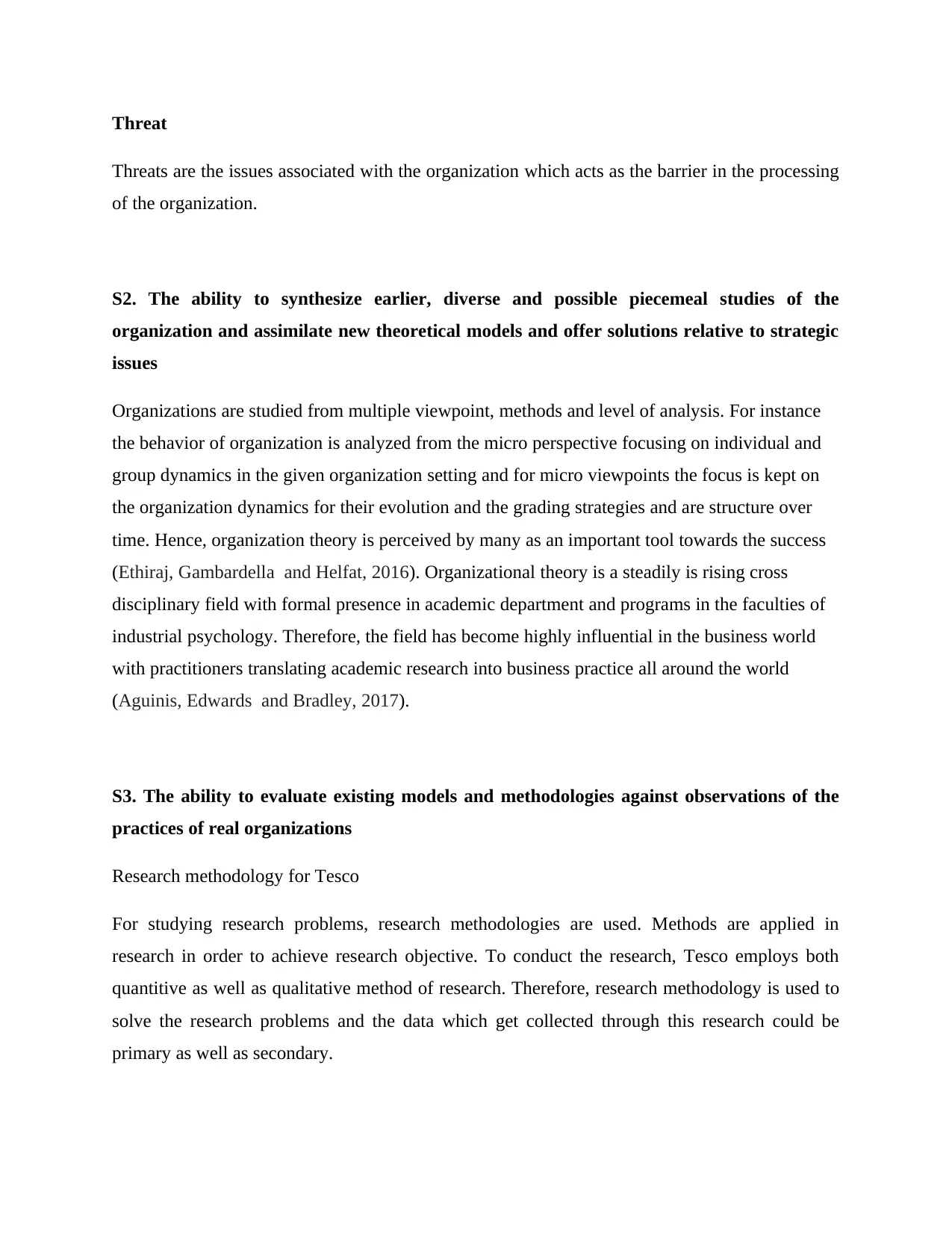
Threat
Threats are the issues associated with the organization which acts as the barrier in the processing
of the organization.
S2. The ability to synthesize earlier, diverse and possible piecemeal studies of the
organization and assimilate new theoretical models and offer solutions relative to strategic
issues
Organizations are studied from multiple viewpoint, methods and level of analysis. For instance
the behavior of organization is analyzed from the micro perspective focusing on individual and
group dynamics in the given organization setting and for micro viewpoints the focus is kept on
the organization dynamics for their evolution and the grading strategies and are structure over
time. Hence, organization theory is perceived by many as an important tool towards the success
(Ethiraj, Gambardella and Helfat, 2016). Organizational theory is a steadily is rising cross
disciplinary field with formal presence in academic department and programs in the faculties of
industrial psychology. Therefore, the field has become highly influential in the business world
with practitioners translating academic research into business practice all around the world
(Aguinis, Edwards and Bradley, 2017).
S3. The ability to evaluate existing models and methodologies against observations of the
practices of real organizations
Research methodology for Tesco
For studying research problems, research methodologies are used. Methods are applied in
research in order to achieve research objective. To conduct the research, Tesco employs both
quantitive as well as qualitative method of research. Therefore, research methodology is used to
solve the research problems and the data which get collected through this research could be
primary as well as secondary.
Threats are the issues associated with the organization which acts as the barrier in the processing
of the organization.
S2. The ability to synthesize earlier, diverse and possible piecemeal studies of the
organization and assimilate new theoretical models and offer solutions relative to strategic
issues
Organizations are studied from multiple viewpoint, methods and level of analysis. For instance
the behavior of organization is analyzed from the micro perspective focusing on individual and
group dynamics in the given organization setting and for micro viewpoints the focus is kept on
the organization dynamics for their evolution and the grading strategies and are structure over
time. Hence, organization theory is perceived by many as an important tool towards the success
(Ethiraj, Gambardella and Helfat, 2016). Organizational theory is a steadily is rising cross
disciplinary field with formal presence in academic department and programs in the faculties of
industrial psychology. Therefore, the field has become highly influential in the business world
with practitioners translating academic research into business practice all around the world
(Aguinis, Edwards and Bradley, 2017).
S3. The ability to evaluate existing models and methodologies against observations of the
practices of real organizations
Research methodology for Tesco
For studying research problems, research methodologies are used. Methods are applied in
research in order to achieve research objective. To conduct the research, Tesco employs both
quantitive as well as qualitative method of research. Therefore, research methodology is used to
solve the research problems and the data which get collected through this research could be
primary as well as secondary.
Paraphrase This Document
Need a fresh take? Get an instant paraphrase of this document with our AI Paraphraser
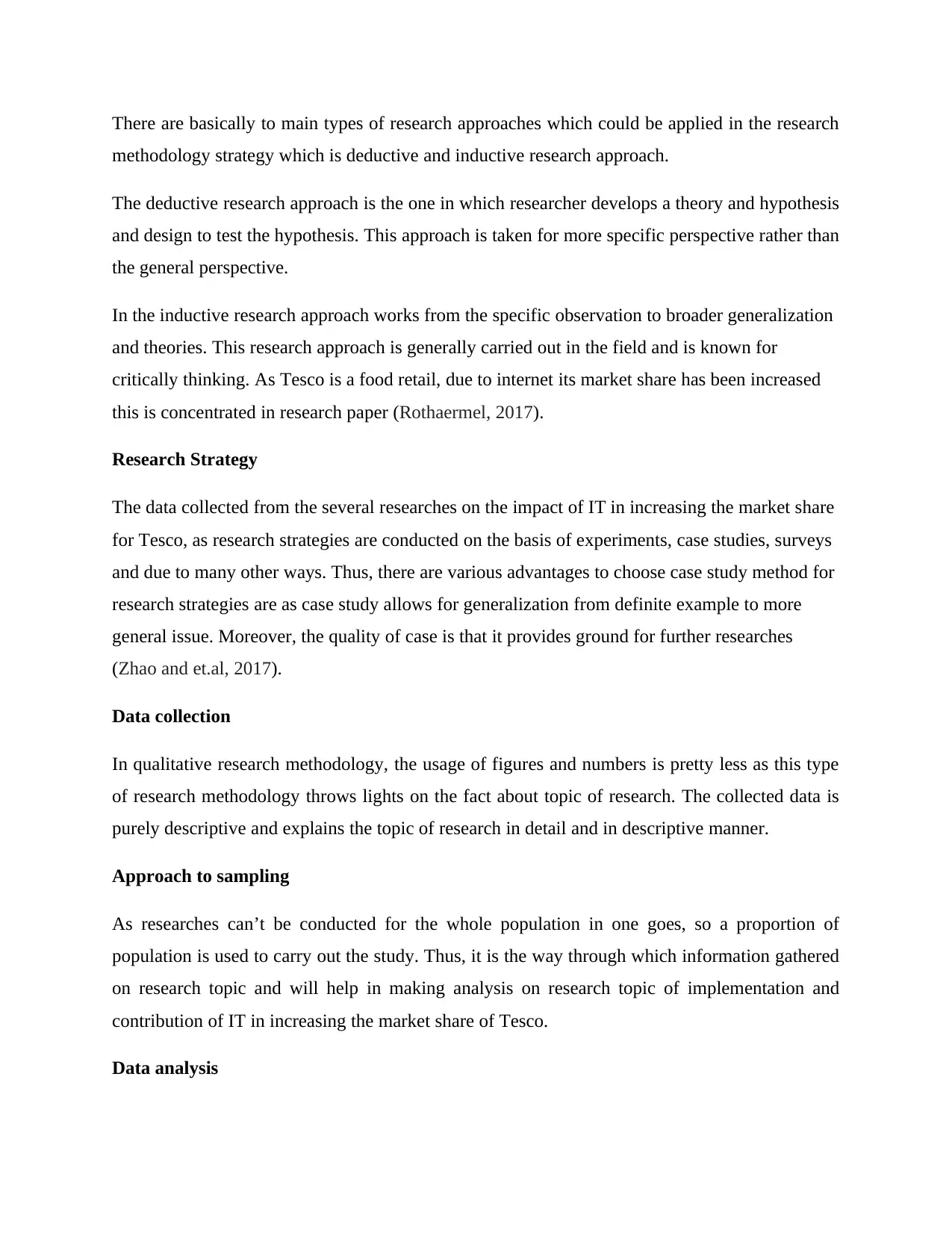
There are basically to main types of research approaches which could be applied in the research
methodology strategy which is deductive and inductive research approach.
The deductive research approach is the one in which researcher develops a theory and hypothesis
and design to test the hypothesis. This approach is taken for more specific perspective rather than
the general perspective.
In the inductive research approach works from the specific observation to broader generalization
and theories. This research approach is generally carried out in the field and is known for
critically thinking. As Tesco is a food retail, due to internet its market share has been increased
this is concentrated in research paper (Rothaermel, 2017).
Research Strategy
The data collected from the several researches on the impact of IT in increasing the market share
for Tesco, as research strategies are conducted on the basis of experiments, case studies, surveys
and due to many other ways. Thus, there are various advantages to choose case study method for
research strategies are as case study allows for generalization from definite example to more
general issue. Moreover, the quality of case is that it provides ground for further researches
(Zhao and et.al, 2017).
Data collection
In qualitative research methodology, the usage of figures and numbers is pretty less as this type
of research methodology throws lights on the fact about topic of research. The collected data is
purely descriptive and explains the topic of research in detail and in descriptive manner.
Approach to sampling
As researches can’t be conducted for the whole population in one goes, so a proportion of
population is used to carry out the study. Thus, it is the way through which information gathered
on research topic and will help in making analysis on research topic of implementation and
contribution of IT in increasing the market share of Tesco.
Data analysis
methodology strategy which is deductive and inductive research approach.
The deductive research approach is the one in which researcher develops a theory and hypothesis
and design to test the hypothesis. This approach is taken for more specific perspective rather than
the general perspective.
In the inductive research approach works from the specific observation to broader generalization
and theories. This research approach is generally carried out in the field and is known for
critically thinking. As Tesco is a food retail, due to internet its market share has been increased
this is concentrated in research paper (Rothaermel, 2017).
Research Strategy
The data collected from the several researches on the impact of IT in increasing the market share
for Tesco, as research strategies are conducted on the basis of experiments, case studies, surveys
and due to many other ways. Thus, there are various advantages to choose case study method for
research strategies are as case study allows for generalization from definite example to more
general issue. Moreover, the quality of case is that it provides ground for further researches
(Zhao and et.al, 2017).
Data collection
In qualitative research methodology, the usage of figures and numbers is pretty less as this type
of research methodology throws lights on the fact about topic of research. The collected data is
purely descriptive and explains the topic of research in detail and in descriptive manner.
Approach to sampling
As researches can’t be conducted for the whole population in one goes, so a proportion of
population is used to carry out the study. Thus, it is the way through which information gathered
on research topic and will help in making analysis on research topic of implementation and
contribution of IT in increasing the market share of Tesco.
Data analysis
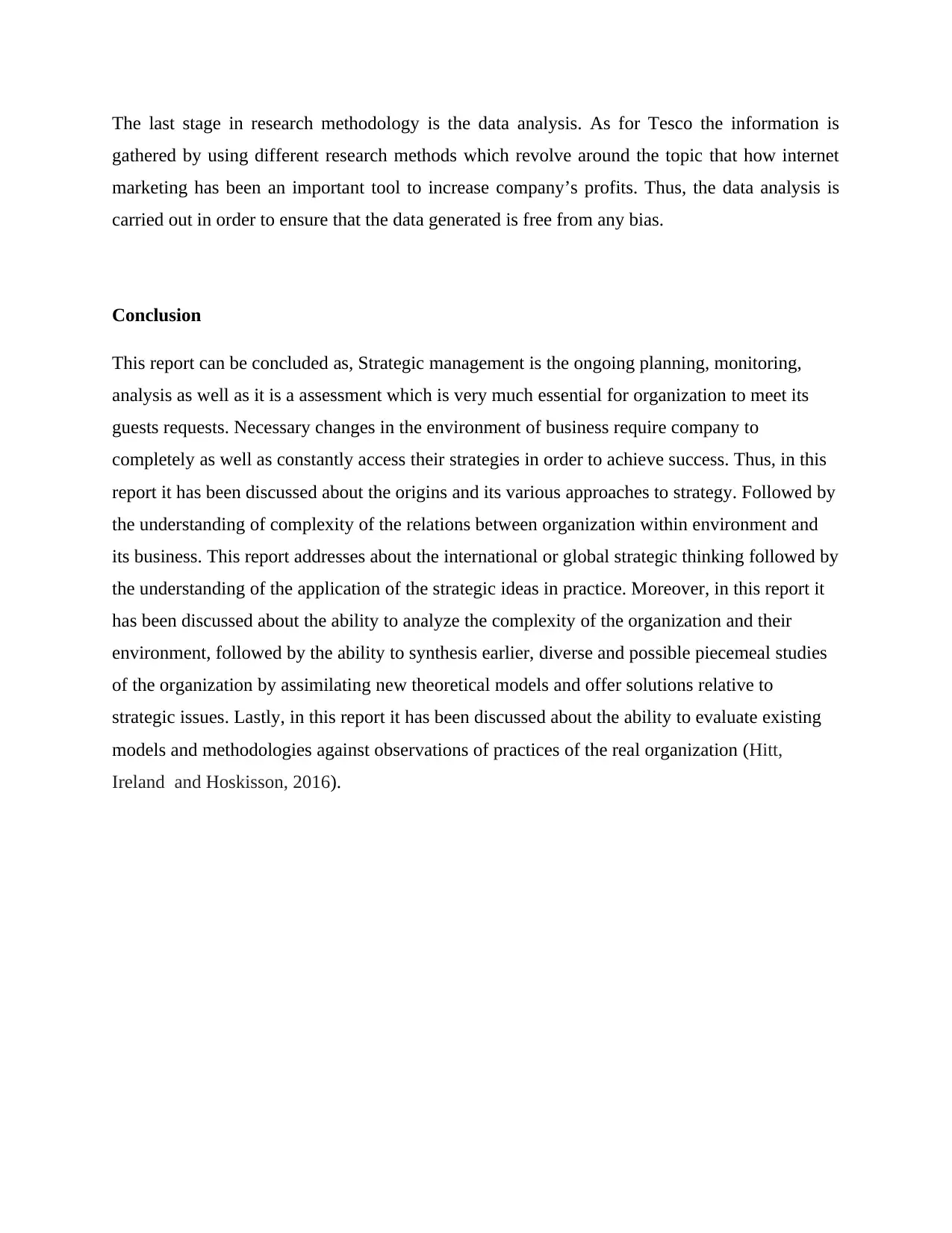
The last stage in research methodology is the data analysis. As for Tesco the information is
gathered by using different research methods which revolve around the topic that how internet
marketing has been an important tool to increase company’s profits. Thus, the data analysis is
carried out in order to ensure that the data generated is free from any bias.
Conclusion
This report can be concluded as, Strategic management is the ongoing planning, monitoring,
analysis as well as it is a assessment which is very much essential for organization to meet its
guests requests. Necessary changes in the environment of business require company to
completely as well as constantly access their strategies in order to achieve success. Thus, in this
report it has been discussed about the origins and its various approaches to strategy. Followed by
the understanding of complexity of the relations between organization within environment and
its business. This report addresses about the international or global strategic thinking followed by
the understanding of the application of the strategic ideas in practice. Moreover, in this report it
has been discussed about the ability to analyze the complexity of the organization and their
environment, followed by the ability to synthesis earlier, diverse and possible piecemeal studies
of the organization by assimilating new theoretical models and offer solutions relative to
strategic issues. Lastly, in this report it has been discussed about the ability to evaluate existing
models and methodologies against observations of practices of the real organization (Hitt,
Ireland and Hoskisson, 2016).
gathered by using different research methods which revolve around the topic that how internet
marketing has been an important tool to increase company’s profits. Thus, the data analysis is
carried out in order to ensure that the data generated is free from any bias.
Conclusion
This report can be concluded as, Strategic management is the ongoing planning, monitoring,
analysis as well as it is a assessment which is very much essential for organization to meet its
guests requests. Necessary changes in the environment of business require company to
completely as well as constantly access their strategies in order to achieve success. Thus, in this
report it has been discussed about the origins and its various approaches to strategy. Followed by
the understanding of complexity of the relations between organization within environment and
its business. This report addresses about the international or global strategic thinking followed by
the understanding of the application of the strategic ideas in practice. Moreover, in this report it
has been discussed about the ability to analyze the complexity of the organization and their
environment, followed by the ability to synthesis earlier, diverse and possible piecemeal studies
of the organization by assimilating new theoretical models and offer solutions relative to
strategic issues. Lastly, in this report it has been discussed about the ability to evaluate existing
models and methodologies against observations of practices of the real organization (Hitt,
Ireland and Hoskisson, 2016).
⊘ This is a preview!⊘
Do you want full access?
Subscribe today to unlock all pages.

Trusted by 1+ million students worldwide
1 out of 13
Related Documents
Your All-in-One AI-Powered Toolkit for Academic Success.
+13062052269
info@desklib.com
Available 24*7 on WhatsApp / Email
![[object Object]](/_next/static/media/star-bottom.7253800d.svg)
Unlock your academic potential
Copyright © 2020–2025 A2Z Services. All Rights Reserved. Developed and managed by ZUCOL.




